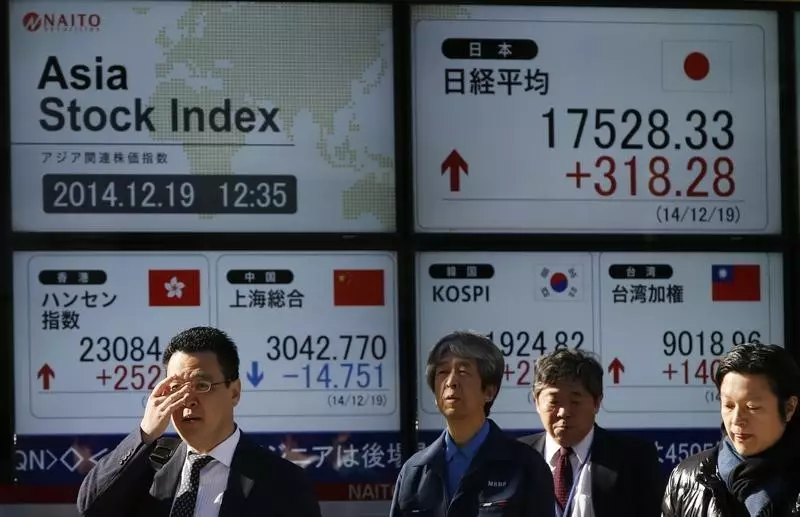As the year draws to a close, Asian stock markets have exhibited a decidedly subdued performance, navigating through a range of economic signals that indicate both promise and risk. With many global stock markets closed for the New Year holiday and key players like Japan and New Zealand away from trading floors, investors find themselves grappling with mixed data coming out of China and the lingering effects of tension in the United States. The overall atmosphere pervading these markets points towards cautious sentiment as the year ends.
The latest figures out of China are painting a worrisome picture. The country’s manufacturing activity has not only shifted to a slower trajectory but is reflecting a troubling divergence from expectations. Private purchasing managers’ index (PMI) data illustrated a less-than-hopeful growth for December, signaling waning effects of the government’s recent stimulus measures. The Shanghai Shenzhen CSI 300 index dropped significantly, while the Shanghai Composite index was not far behind in recording losses. This decline can be attributed to investor apprehension regarding the efficacy of governmental policies designed to spur economic activity. Following earlier government data that hinted at modest expansion, market players are increasingly uncertain about the sustainability of this growth trend, leading to speculation that future measures will be necessary to sustain momentum.
Adding to the regional turmoil, Hong Kong’s Hang Seng index witnessed a staggering drop of 1.7%. Notably, the sharp decline in shares of Sun Art Retail perfectly encapsulated the retail sector’s volatility. The company’s stock tumbled over 30% following Alibaba’s announcement to divest its majority stake in the firm. This development raises serious questions about investor confidence and the retail landscape in Hong Kong. The market is now keeping a vigilant eye on possible ramifications for the e-commerce giant, which had invested heavily in the retail giant. This move could signal a more extensive restructuring within the retail sphere, potentially alarming investors about the sector’s prospects moving forward.
In Singapore, the economic landscape appears equally lackluster. The Straits Times Index held steady on Thursday, yet the country’s GDP growth revealed stark challenges. A meager increase of 0.1% in the fourth quarter fell significantly short of projections, raising alarms about the long-term viability of the economy. While annual growth exceeded 4%, the sluggishness in recent quarters is largely attributed to weakening export demands and slower growth in its biggest trading partner, China. The resilient financial sector offers a glimmer of hope, but the manufactured goods sector has been grappling with persistent challenges, particularly in the electronics space, making the future uncertain.
Regional markets have also been buffeted by additional external factors, including strong tensions between the United States and China. The incoming leadership in the U.S. has signaled intentions to impose tariffs that could ignite further strain in trade relations. This uncertainty is taking a toll on market sentiments across Asia, creating a backdrop of anxiety that investors are keenly aware of. Coupled with the Federal Reserve’s recent meetings emphasizing reduced cuts in monetary policy as inflation remains a pressing concern, the outlook for Asian markets continues to darken.
Despite the broader downcast sentiment, it is essential to recognize the mixed results across different markets. Malaysia’s FTSE KLCI index faced a mild decrease of 0.4%, while the Philippines’ PSEi Composite saw a slightly larger drop of 0.6%. Interestingly, Australia’s S&P/ASX 200 managed a slender gain of 0.4%, showcasing the diverse responses of markets to similar economic stimuli. Meanwhile, in South Korea, political turbulence adds another layer of complexity. The ongoing political unrest surrounding President Yoon Suk Yeol has created an atmosphere of uncertainty, further complicating the investment landscape.
As Asian markets close the curtains on 2024, the view ahead is anything but clear. Investors are left to sift through the confusing signals from China’s manufacturing sector, the repercussions of regional political developments, and the broader international economic landscape dominated by U.S.-China relations. The coming weeks will be pivotal. With year-end evaluations underway, clarity on central bank policies, economic growth figures, and potential fiscal alterations from Beijing will be essential to inform and possibly alter investor sentiment. Caution seems to be the watchword as we transition into the new year, and adaptability will be critical for navigating these turbulent waters.

